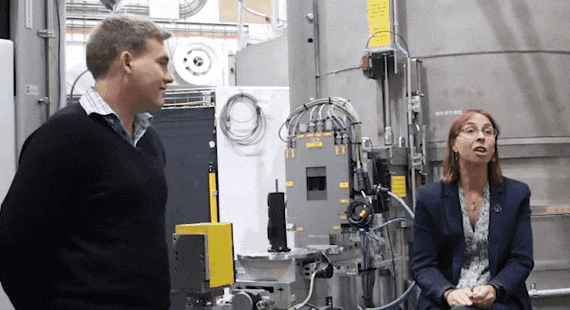- New research supports development of thermoelectric devices to convert waste heat from industry into a viable new energy source
- Australian industries could benefit from being able to harness the heat by-products from operations
Development of advanced materials can sustainably convert waste heat into useful forms of energy to benefit Australia.
The work will be undertaken as part of an Australian Research Council Linkage Project awarded to a team led by Prof Xiaolin Wang and Dr Zengji Yu (University of Wollongong), with FLEET partner organisation ANSTO.
A great variety of Australian industries that produce excess waste heat will benefit from these new thermoelectric technologies, including manufacturing, mining, IT, transport, and energy, among others.
They could potentially be used to provide electricity at remote mining sites and power portable sensors and detectors.
At the present time, the conversion efficiency is relatively inefficient and the underlying technology is costly. This limits it to niche applications in sectors such as space and oil and gas production.
A lack of suitable materials has hindered the development of the technology but that is about to change.
This research is expected to deliver reliable, high-performance, and cost-effective products that can operate a range of temperatures with higher efficiency than the current commercially available materials.
FLEET AI Dr David Cortie (ANSTO, UOW) and FLEET PI Dr Kirrily Rule (ANSTO) are Chief Investigator and Partner Investigator respectively on the project, which is expected to lead to next-generation thermoelectric devices.
These devices rely on multifunctional, nano-engineered topological materials using bismuth telluride and antimony alloys developed by Prof Wang that show great promise as high-performing thermoelectric materials. The process can also be used to convert heat into cooling and light into heat.
“There is a tremendous amount of waste energy in the form of heat that is just lost every year. Even recycling a small percentage of that would be a great gain,” said Cortie.
Both Rule and Cortie have significant experience in the characterisation of thermoelectric materials using neutron spectroscopy and related techniques. Recently they have broadened the search to include a new generation of materials known as topological insulators.
These materials have high electrical conductivity on their surface but act as insulators in the bulk.
“We have worked in this area for quite some time. The basic science came first. But now we have reached a point, where the knowledge can be applied to materials that are more commercially relevant,” said Cortie.
In thermoelectric studies, the figure of merit to compare the effectiveness of different materials is known as zT.
“The zT of a good thermoelectric is presently approximately 1. If we were able to get that to climb to 2 or beyond it would be extremely competitive,” said Cortie.
Previous collaborative research by the same group achieved a zT of approximately 2.44 at 873 Kelvin with a significant reduction in thermal conductivity but encountered issues with reliable cycling stability. This led the group to apply similar principles to different materials, and ultimately to chalcogenide topological insulators.
“Other ANSTO instrument scientists, in addition to Kirrily, including Richard Mole and Dehong Yu have contributed to fundamental research, that led to the development of these materials,” said Cortie.
ANSTO can support investigations into advanced materials, such as topological insulators, by the operation of a suite of neutron spectrometers in the Australian Centre for Neutron Scattering.
Neutron spectroscopy can detect and quantify high energy vibrations in atoms, such as phonons, at the quantum scale.
“We are using neutrons, that can penetrate deep into a material to gain information about the motion of atoms in it, that are contributing to its thermoelectric performance,” said Rule.
In recent breakthrough research, Prof Wang embedded nanoparticles in the materials to try and impede the flow of phonons, atomic vibrations that carry heat.
“In this case, we want to understand how heat is transported through the materials and it is phonons that are transporting this heat,” said Rule.
“In order to reduce how quickly the heat can move through the material, you need to block the propagation of phonons, reducing their lifetime,” she explained.
“Our triple-axis spectrometer Taipan operates at the appropriate energy level to measure phonons at very high temperatures,” she said.
While measurements on the time-of-flight spectrometer Pelican can provide an overview of the material.
“By manipulating chemical processes, you can improve the properties of materials. The inclusion of nanoparticles appears to be responsible for this effect,” said Rule
The team also anticipates using techniques at the Australian Synchrotron (also a FLEET partner organisation) for further investigations.
The research is expected to include processes that convert light into energy in the form of electricity, heat, evaporation, or cooling.
“With the amount of sunlight that Australia receives, this is potentially also a great resource. These versatile materials also show promise for these applications,” said Cortie.
The development of new clean energy sources that are efficient, cost-effective, and reliable is an Australian research priority.
More information
- Contact Prof Xiaolin Wang (UOW) xiaolin@uow.edu.au
- Contact Dr David Cortie (ANSTO, UOW) dcr@ansto.gov.au
- Contact Dr Kirrily Rule (ANSTO) kirrily@ansto.gov.au
- Explainer: Topological-thermoelectrics (Zengji Yu)
—written by Susan Boyle, Senior Communications and Science Writer, ANSTO (original article)


